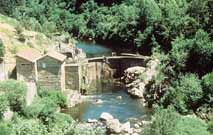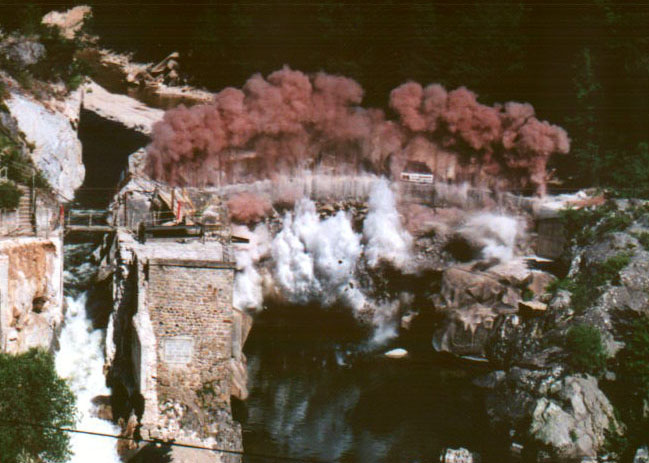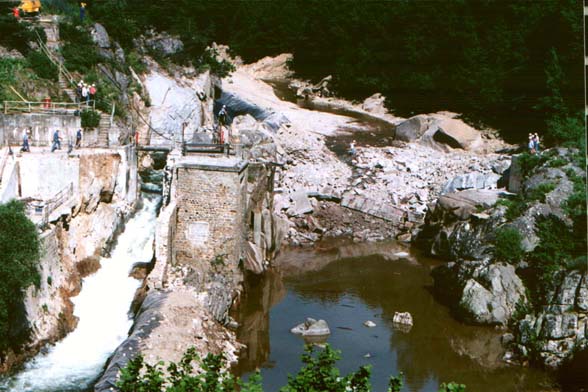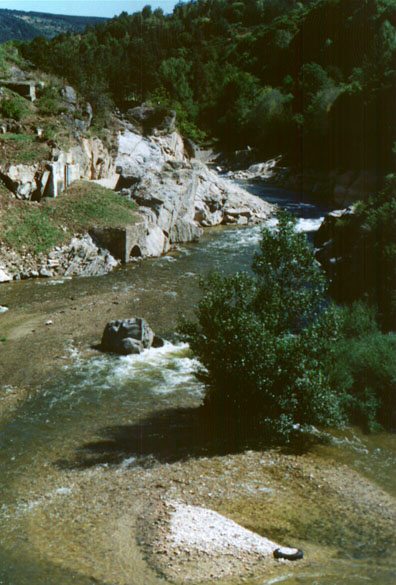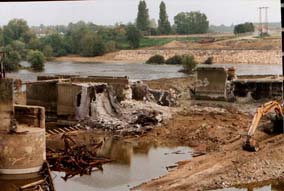
by
ERN |
and the Maison Rouge Dam dismantled for Salmon français - deutsch |
||
|
Dam
decommissioning in France
|
|
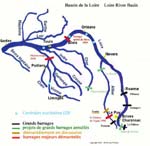
The Saint Etienne de Vigan dam The Saint-Etienne-du-Vigan dam on the Upper Allier river, the main tributary of the Loire river, collapsed on June 24 at 5 P.M. It is the first time in France that a dam operated by Electricité de France (the French state-owned electricity utility ) has been destroyed in an effort to restore salmon habitat. Located near the sources of the Allier River, Saint-Etienne-du-Vigan sterilized 70 acres of the basin's best salmon (Salmo salar) spawning grounds. Before this 44-foot-high dam was built in the late XIXth century, the surrounding villages produced approximately 10 tons of salmon per year, which contributed heavily to the local economy. The dam produced just 35 Mwh per year, a tiny fraction of the local electrical output. In the fall 1997, the dam reservoir was emptied when a flood of about 2,800 cubic feet per second (80 cubic meters/sec.) occurred, which washed out the accumulated silt in the reservoir and minimized damage on the ecosystem downstream. Studies found no evidence of sudden pollution downstream, due to the low level of pollution of the reservoir sediments, as the reservoir is located in very little urbanized area and suffers hardly no pollution. The global cost of the demolition is an estimated FF14 million ($2,3 million*), including FF7,2 million ($1,2 million) to replace professional taxes formerly paid by EDF. This money will go for measures to improve the village’s habitat and tourism infrastructures. The decision to remove the dam was taken on January 4, 1994, when the « Plan Loire Grandeur Nature » was launched by the French government. This program, spurred by widespread opposition coordinated by the Loire Vivante network to a series of projected dams on the Loire river basin, planned several measures to save the remaining salmon population of the Loire basin, including demolition of another dam on the Loire basin, construction of a hatchery on the Upper Allier, suspension of all fishing and elimination of other obstacles to salmon migration. The other dam to be dismantled is the Maisons-Rouges, on the Vienne river, another tributary of the Loire river. The process has been slowed by the opposition of local politicians but the current French government has now scheduled a timetable for taking down this 15-foot-high hydroelectric dam which destroyed the Vienne river basin's entire 1,900 acres of spawning grounds : the works will begin next September 1998. The goal of the program to restore salmon population on the Loire basin is to have 6,000 adults return to the Loire estuary in the years 2008. In the XIXth century, approximately 100,000 Atlantic salmon would make the annual journey to their spawning grounds in the headwaters of France’s Loire River and its tributaries. After travelling an amazing 4,000 miles from Greenland in the North Atlantic ocean, they would swim upriver to spawn in clear waters. In 1997, only 389 salmon were counted on the middle Allier River, the sole tributary in the Loire basin where salmon still return to spawn. Dams were the main cause for the spectacular drop in the salmon population. Young smolts swimming downstream to the ocean get lost in the slack waters of the reservoirs or chopped up in turbines or pumps; adults swimming upstream are foiled by dam walls or indequate fish ladders. Numerous dams in the Loire basin have destroyed habitat and blocked the fish from their spawning grounds. Atlantic salmon
have disappeared from all large rivers on the European Atlantic coast:
the Rhine, the Thames, the Elbe, and others. This makes the tiny Loire
stock a precious genetic pool for reintroducing salmon in other large
European rivers because it the only salmon in Europe which is able to
swim upriver for such long distances (more than 600 miles).(* rate used
: 1$ = 6 FF)
more information on St. Etienne de Vigan
|
|
